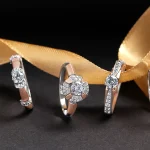Designing your own engagement ring is a meaningful and exciting journey that allows you to create a piece of jewelry that perfectly reflects your style, preferences, and the uniqueness of your love story. With Lab grown Solitaires gaining popularity for their ethical sourcing and brilliant quality, designing a custom lab-grown diamond engagement ring offers a blend of sustainability, craftsmanship, and personalization. Here’s a comprehensive guide to help you navigate the process of creating your own lab-grown diamond engagement ring.
1. Inspiration and Vision:
Before diving into the design process, take some time to gather inspiration. Browse through jewelry catalogs, online galleries, and Pinterest boards to explore different styles, settings, and Lab grown Diamonds INDIA shapes. Consider your lifestyle, personal taste, and the overall aesthetic you envision for your ring. Whether you prefer a classic solitaire, a vintage-inspired halo setting, or a modern twist on a traditional design, collecting images and ideas will help you articulate your vision to the jeweler.
2. Choose Your Diamond:
One of the most exciting aspects of designing your engagement ring is selecting the diamond. Lab-grown diamonds offer a wide range of choices in terms of shape, size, color, clarity, and cut. Here’s a breakdown of key considerations:
-
Shape: Popular diamond shapes include round, princess, cushion, oval, pear, and emerald. Choose a shape that resonates with your style and preferences.
-
Color: Lab-grown diamonds are available in various colors, ranging from colorless (D-F grades) to fancy colors (such as blue, yellow, or pink). Decide whether you prefer a classic white diamond or a unique colored diamond.
-
Clarity: Consider the clarity of the diamond, which refers to the absence of internal flaws (inclusions) and surface blemishes. Diamonds with higher clarity grades (such as VS or VVS) have fewer imperfections and appear more flawless.
-
Cut: The cut of a diamond determines its brilliance and sparkle. Choose a well-cut diamond that maximizes light reflection and enhances its beauty.
Discuss these factors with your jeweler to narrow down your options and find a diamond that meets your specifications and budget.
3. Select a Setting:
Once you’ve chosen your diamond, select a setting that complements its shape and enhances its brilliance. Common engagement ring settings include:
-
Solitaire: A single diamond set on a plain band, focusing attention on the center stone.
-
Halo: A ring of smaller diamonds (or other gemstones) surrounding the center diamond, adding sparkle and visual impact.
-
Pave: Small diamonds set closely together on the band, creating a continuous sparkle.
-
Vintage: Intricate designs inspired by historical periods, featuring intricate details and filigree work.
-
Modern: Sleek and minimalist designs that emphasize the diamond’s beauty with clean lines and contemporary settings.
Consider your lifestyle and daily activities when choosing a setting. A low-profile setting may be more practical for active individuals, while a more ornate setting may appeal to those who appreciate intricate designs.
4. Customize Details:
Personalize your ring by customizing details such as metal type, band width, and additional design elements. Common choices for engagement ring metals include platinum, white gold, yellow gold, and rose gold, each offering unique aesthetics and durability. Determine whether you prefer a polished, matte, or textured finish for the band.
You can also incorporate symbolic elements or engraving on the inside of the band, such as initials, dates, or a meaningful phrase that holds significance to you and your partner.
5. Consult with a Jeweler:
Working with a reputable jeweler or custom jewelry designer is essential to bringing your vision to life. Schedule a consultation to discuss your design ideas, review diamond options, and finalize details such as budget and timeline. A skilled jeweler will provide expert guidance, share design mock-ups or CAD (computer-aided design) drawings, and ensure that every aspect of your ring meets your expectations.
During the consultation, don’t hesitate to ask questions about the craftsmanship, sourcing of materials, and warranties or guarantees associated with your custom ring. Clear communication with your jeweler will ensure a smooth and enjoyable experience throughout the design process.
6. Review and Approve the Design:
Once the design is finalized, review detailed drawings or digital renderings of your ring to visualize how it will look once completed. This step allows you to make any final adjustments or modifications before giving the jeweler approval to proceed with crafting your ring.
7. Enjoy Your Custom Creation:
After patiently waiting for your custom lab-grown diamond engagement ring to be crafted, the moment arrives when you finally get to see and wear your unique creation. Celebrate this special milestone with your partner and cherish the symbolism and beauty of a ring that was designed especially for you.
Conclusion:
Designing your own lab-grown diamond engagement ring offers a blend of creativity, personalization, and ethical sourcing that aligns with modern values. By following this guide and collaborating with a skilled jeweler, you can create a ring that not only symbolizes your love and commitment but also reflects your individual style and preferences. Embrace the journey of designing a meaningful piece of jewelry that will be treasured for a lifetime.

